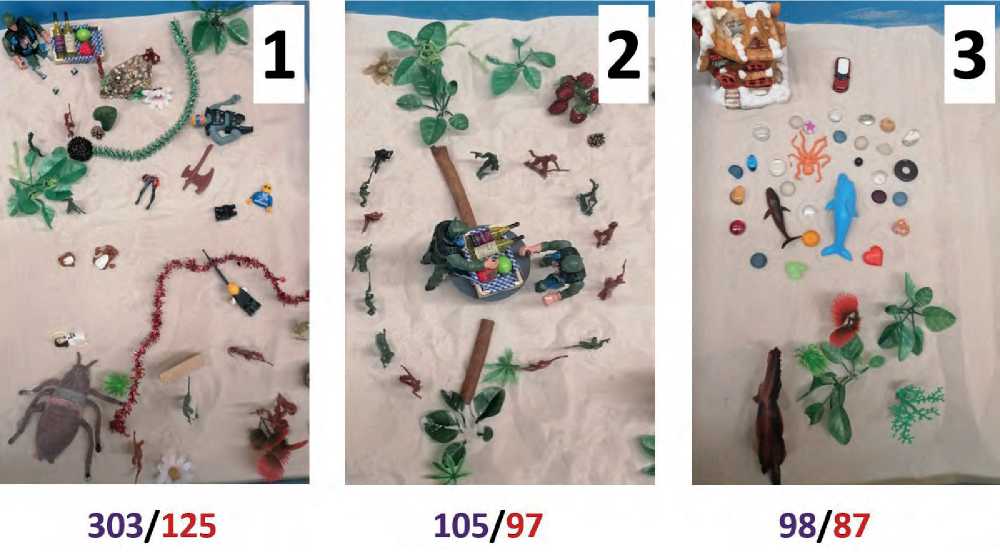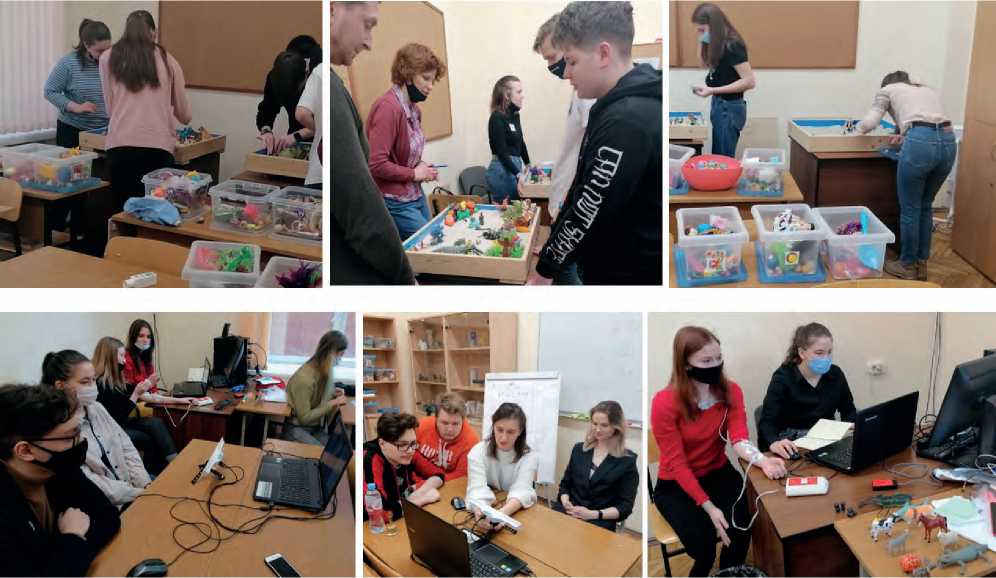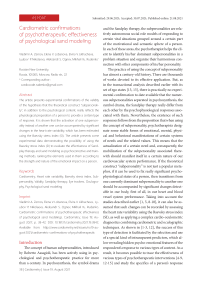Cardiometric confirmations of psychotherapeutic effectiveness of psychological sand modeling
Автор: Vladimir A. Zernov, Elena V. Lobanova, Elvira V. Likhacheva, Lyubov’ P. Nikolaeva, Aleksandr S. Ognev, Mikhail Yu. Rudenko
Журнал: Cardiometry @cardiometry
Статья в выпуске: 19, 2021 года.
Бесплатный доступ
The article presents experimental confirmations of the validity of the hypothesis that the theoretical construct “subpersonality”, in addition to the psychological content, really reflects the physiological preparation of a person to provide a certain type of response. It is shown that the activation of one subpersonality instead of another one can be accompanied by significant changes in the heart rate variability, which has been estimated using the Baevsky stress index (SI). The article presents some experimental data demonstrating the possibility of using the Baevsky stress index (SI) to evaluate the effectiveness of Sandplay therapy and sand modeling as psychocorrective and training methods, ranking the elements used in them according to the strength and nature of the emotional impact on a person
Cardiometry, Heart rate variability, Baevsky stress index, Subpersonality, Validity, Sandplay therapy, Eye trackers, Oculography, Psychological sand modeling
Короткий адрес: https://sciup.org/148320548
IDR: 148320548 | DOI: 10.18137/cardiometry.2021.19.3842
Текст научной статьи Cardiometric confirmations of psychotherapeutic effectiveness of psychological sand modeling
Vladimir A. Zernov, Elena V. Lobanova, Elvira V. Likhacheva, Lyubov’ P. Nikolaeva, Aleksandr S. Ognev, Mikhail Yu. Rudenko. Cardiometric confirmations of psychotherapeutic effectiveness of psychological sand modelings. Cardiometry; Issue 19; August 2021; p. 38-42; DOI: 10.18137/cardiometry.2021.19.3842; Available from:
The concept of human subpersonalities, introduced by Roberto Assagioli, has been actively using in psychological and psychotherapeutic practice for more than a century. In psychosynthesis, the symbol drama 38 | Cardiometry | Issue 19. August 2021
and the Sandplay therapy, the subpersonalities are relatively autonomous social role models of responding to certain vital situations grouped around a certain part of the motivational and semantic sphere of a person. In each of these areas, the psychotherapist helps the client to identify his/her dominant subpersonalities in a problem situation and organize their harmonious connection with other components of his/her personality.
The practice of using the concept of subpersonality has almost a century-old history. There are thousands of works devoted to its effective application. But, as in the transactional analysis described earlier with its set of ego states [13, 15], there is practically no experimental confirmation to date available that the numerous subpersonalities separated in psychosynthesis, the symbol drama, the Sandplay therapy really differ from each other by the psychophysiological responses associated with them. Nevertheless, the existence of such responses follows from the proposition that when using the concept of subpersonality, psychotherapists designate some stable forms of emotional, mental, physical and behavioral manifestations of certain systems of needs and the related values. This means that the actualization of a certain need and, consequently, the mobilization of the subpersonality associated therewith should manifest itself in a certain nature of our cardiovascular system performance. If the theoretical construct “subpersonality” is not just a popular metaphor, if it can be used to fix really significant psychophysiological states of a person, then transitions from one currently dominant subpersonality to another one should be accompanied by significant changes detectable in our body, first of all, in our heart and blood vessel system performance. Taking into account the studies described earlier [1, 5, 8-10], it can also be assumed that such changes can be recorded by assessing the heart rate variability using the Baevsky stress index (SI), as well as applying a complex cardio-oculometric diagnostics combining cardiometric and oculographic techniques. As shown in [1-3, 12], the success of this type of detection is facilitated by the selection and use of a special kind of intransparent predictors, which allow revealing hidden psycho-emotional features of the respondent’s response to various types of content. As a result, it becomes possible to trace the effectiveness of various types of psychotherapeutic interventions [4-9, 12-15] and study the specifics of a person’s response to various types of informational and other stressful effects in terms of their potential [2-5, 7-12].
Materials and Methods
To test the hypothesis presented above, we conducted a set of experiments which covered the use of thematic sand compositions constructed by 92 respondents themselves with identification of the most frequently selected elements in them as stimulus material.
The work with each thematic composition included the following stages. At the beginning, each respondent was asked to build a composition in a sand container from a set of figurines offered to him/her (their total number included more than a thousand figurines), which the respondents currently associated with such a concept as “War”. After discussing the content of this composition with a psychologist and photographing it, each participant of the experiments was asked to transform his/her composition so that it was maximally associated with the concept of “Peace”. Then there was also a discussion about the new composition with a psychologist and photographing. The final task for each respondent was to create a composition, which he/she associated with the concepts of his/her “Maximum comfort”, “A place of rest, positive strength and energy”. The produced composition was also discussed with a psychologist and photographed. Examples of the created sand compositions are shown in Figure 1 herein, and they are numbered 1, 2 and 3, respectively.
At the next stage, each respondent alternately fixed his/her attention for 25-30 seconds on the images of the compositions built by him/her. And at that time, with the help of PC-aided cardiograph instrument Cardiocode, his/her cardiogram was recorded. Then, in turn, each respondent was presented with figurines, which most often induced either negative or positive associations in the test subjects. In our experiment, such figurines were miniature toy models of a shark, a cow, a huge beetle, grapes, a crocodile, an apple, a lion, a sheep, a horse, a goat and an elephant. Then the respondents were asked to collect together the most positive, in their opinion, figurines and focus their attention on that entire group. When fixing attention on each of those figurines, a cardiogram was also recorded, followed by the calculation of the average SI values and the heart rate values (HR). After that, the respondents worked with an eye tracker, which was used to study their individual peculiarities of visual information perception. Figure 2 illustrates how the respondents have completed the above listed stages of their testing.

303/125
105/97
Figure 1. Examples of thematic sand compositions used in the experimental part of our work (numbers in the figure refer to the compositions as follows: 1 – “War”; 2 – “Peace”; 3 – “Maximum comfort”, “A place of rest, positive strength and energy”). The natural fractions given under each figure part are made up of the actual value of SI (numerator) recorded in the process of fixing the respondent’s attention on the image in question and the HR value representing an average value of the heart rate (denominator).

Figure 2. An illustration of the respondents who have completed various stages of the experiment, including construction and discussion of thematic sand compositions, examinations with PC-aided cardiograph instrument Cardiocode and an eyetracker.
Results and Discussion
The obtained statistical patterns and regularities in determining the respondents ‘ SI values during fixing their attention on some visual stimuli used are shown in Table 1 herein. The numbers in the first column of the Table indicate the following: 1 – sand compositions “War”; 2 – sand compositions “Peace”; 3 – sand com- Table 1
Main statistical parameters of SI for various visual stimuli
As shown in the Table, the smallest arithmetic mean and the median values of SI were obtained when the respondents worked with images of their thematic compositions “Peace” and “Maximum Comfort”, “A place of rest, positive strength and energy”, as well as when fixing the respondents’ attention on the figurines of an apple and grapes, a cow and those groups of the figurines that the respondents have chosen as the most positive items.
It also follows from the above Table that the largest arithmetic mean and the median values of SI were obtained when the respondents worked with images of compositions constructed by them on the “War” theme. The largest arithmetic mean and median values of SI were obtained when the respondents fixed their attention on the models of the crocodile, the goat, the horse, the beetle and the shark. Intermediate values of the arithmetic mean and median were identified for the SI parameters derived from the cardiometric in- dicators recorded during the respondents’ work with the figurines of the lion, the sheep and the elephant. It should be noted that for the elephant model, the median values were closer to the smallest.
The congruence between the detected SI values and the respondents’ internal experiences is markedly illustrated by the recorded associations with the corresponding stimuli. The nature of the most frequent associations is quite clearly conveyed by the comments of the respondents as listed below. Thus, when focusing their attention on the shark model, “pain”, “fear”, “horror”, “panic”, “irreconcilable ruthless aggression” etc. were most often called. In relation to the model of the large beetle, the respondents mentioned their “animal fear”, “disgust”, “desire to withdraw my hand”, “I want to isolate myself from it, not to face it”. Examples of typical associations recorded in the participants of the experiments in the process of fixing their attention on the cow were as follows: “Kind, helps people survive”, “Remembering childhood, when visiting my grandmother in summer”, “Country house, friends brought a large jar of fresh milk from the village”. Typical associations with the toy grapes and apples were as follows: “juicy”, “delicious”, “sweet”, “remembering a summer garden”, “pleasure”. The images of the “War” compositions were associated with such concepts as “fear”, “destruction”, “death”, with the desire to escape, with quarrels, resentment, with the loss of loved ones”. Images of the “Peace” compositions were associated with calmness, pleasant memories, a sense of peace. Images of the “Comfort” compositions were linked with a sense of self-confidence, ideas about the “ideal world”, “with what makes you smile” etc.
These associations are useful to understand why, as can be seen from the Table, the models of the shark, the huge beetle, the crocodile, images of the composition on the theme “War” most often caused a significant increase in the stress index. These associations are also quite consistent with the fact that the prevailing trend for the models of the cow, the apple and grapes, for the group of models chosen by respondents as the most positive, as well as for images of thematic compositions “Peace” and “Maximum comfort”, “A place of rest, positive strength and energy” was a decrease in the stress index values.
In this regard, the multiple ambiguous associations that the respondents had when focusing on the model of the goat and the horse were also very indicative. On the one hand, when focusing on the model of the goat, the associations were traced as follows: “great vitality”, “enthusiasm and fun”, “remembering my childhood”.
But on the other hand, the associations were clearly negative (their number significantly exceeded the positive ones) such as: “stubbornness”, “my ex-husband” (the SI value of the respondent in that case reached 3214 arbitrary units!), “sole proprietor”, “useless”, “unpleasant” etc. When working with the figurine of the horse, many respondents recalled how they rode horse. For them, it was both “interesting” and “risky”. For others, it was “the power that knocks down, crushes everything in its path.” Someone said that the dangerous creature, which “did not know where it was running,” could throw off a rider and trample him”. But some of the respondents remembered a cute animal that they once faced. In the latter case, some of the respondents included a horse in the group of those figurines which induced positive associations in them.
The relationship between what type of associations the respondents were tended to initiate and what ocu-lographic responses they showed, when working with the eytracker, is also thrilling. It turned out that mostly negative associations, when focusing on various figurines, arose in those respondents who were characterized by increased attention to the visual symbols of a personal failure presented with the help of an eytracker (a tripped person, the contours of the skull etc.). Positive associations appeared much more often among the respondents who, even when working with an eytrack-er, were tended to fix their attention on the life-affirming components of the visual stimuli (a person helping another to stand up, a beautiful harmonious-looking lotus, etc.). In addition, viewing the video recordings of the respondents ‘ facial expressions, traced by the eytracker, showed that the respondents, who rejected the image of the cow, who were prone to negative associations when working with this figurine, as a rule, demonstrated their frown or a mournful expression. Those respondents who positively perceived the above mentioned figurine and demonstrated its acceptance, when working with the eytracker, most often smiled or at least kept a complacent expression on their face.
Conclusions
The article presents experimental confirmations of the validity of the hypothesis that the theoretical construct “subpersonality” used in the Sandplay therapy and psychological sand modeling, in addition to the psychological content, really reflects the psychophysiological preparation of a person to produce a certain type of responses. Such preparation is manifested in a certain nature of the cardiovascular system performance, the actualization of relevant memories, in the attitude to the most acceptable type of the behavior for this person in this case.
It was found that the change of dominant subpersonalities by transferring attention from one of the elements, used in the Sandplay therapy and psychological sand modeling, to another one can be accompanied by significant changes in our body, first of all, in our heart performance. Estimates of heart rate variability using the Baevsky stress index (SI) serve as a reliable reflection of such changes.
In addition, as in [12-15], we obtained experimental confirmation of the validity of using such a complex cardiometric indicator as the Baevsky stress index (SI) to assess the effectiveness of various psychotherapeutic and correctional methods. But if earlier it has been applicable to the methods of psychosomatic self-regulation [12, 14], the transactional analysis [13], the metaphorical and coaching associative maps [15], now similar possibilities are demonstrated by the Sandplay therapy and the psychological sand modeling. At the same time, the obtained data clearly show the existence of a fundamental possibility of using the Baevsky stress index (SI) for ranking elements used in the Sandplay therapy and the psychological sand modeling according to the strength and nature of their emotional impact on a person.
Statement on ethical issues
Research involving people and/or animals is in full compliance with current national and international ethical standards.
Conflict of interest
None declared.
Author contributions
The authors read the ICMJE criteria for authorship and approved the final manuscript.
Список литературы Cardiometric confirmations of psychotherapeutic effectiveness of psychological sand modeling
- Azarov AA, et al. Predictor Mining: Data Mining application to Social Computing. SPIIRAS Proceedings. 2013. Issue 3(26). I
- Brodovskaya EV, et al. Specific use of id trackers in combination with a focused interview in certification of network content . Chelovecheskii kapital. 2021. No 1(145). DOI: 10.25629/HC.2021.01.07 [in Russian]
- Brodovskaya E, et al. Intelligent search for strategies to minimize the risks of internet communication of teens and youth. Advances in Intelligent Systems and Computing. 2021;1183:261-8. DOI: 10.1007/978-981-15-5856-6_26.
- Likhacheva EV, Ognev AS, Kazakov KA. Hardiness and purposes in life of modern Russian students. Middle-East Journal of Scientific Research. 2013;14(6):795-8. DOI: 10.5829/idosi.mejsr.2013.14.6.2138.
- Ognev AS. Cardio-oculometric (cardio-oculographic) detection of functional states in a human individual. Cardiometry. 2019;14:104-5.
- Ognev AS, Likhacheva EV. Implementation of Positive Subjectivity Genesis in Higher Education System. Psychology. Journal of the Higher School of Economics. 2014;11(2): 51-67.
- Ognev AS, et al. Cardiometric detection of effects and patterns of emotional responses by a human individual to verbal, audial and visual stimuli. Cardiometry. 2019;14:79-86. DOI: 10.12710/cardiometry. 2019.14.7986.
- Ognev AS, et al. Use of cardiometry and oculography in concealed information detection. Cardiometry. 2019;14:87-95. DOI: 10.12710/cardiometry.2019.14.8795.
- Ognev AS, et al. Validity of cardiometric performance data: an integral part of complex assessment of training session effectiveness. Cardiometry. 2019;14:96-100. DOI: 10.12710/cardiometry.2019.14.96100.
- Rozenova MI, et al. Fear as a mental health crisis in the context of global risks and changes. Journal of Modern Foreign Psychology. 2021;10(1): 17-26. DOI: 10.17759/jmfp.2021100102
- Rozenova MI, et al. Stress and fear in extreme situations. Journal of Modern Foreign Psychology. 2020; 9(1):94-102. DOI:10.17759/jmfp.2020090110
- Zernov VA, et al. Application of the computer cardiograph “Cardiocode” in engineering and social psychology. Vysshee obrazovanie segodnya. 2019;3:68-75. [in Russian]
- Zernov VA, et al. Cardiometric fingerprints of various human ego states. Cardiometry. 2019;15:38-42.
- Zernov VA, et al. Cardio-oсulometric indicators of psychophysiological readiness of students to examinations. Cardiometry. 2020; 16:28-34.
- Zernov VA, et al. Cardiometric evidence data on human self-control of emotional states in the context of the use of metaphoric associative cards. Cardiometry. 2020; 16:55-61.


